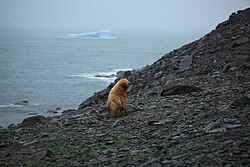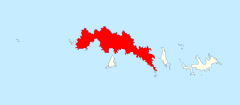Difference between revisions of "Coronation Island"
(Created page with "{{Infobox island |name=Coronation Island |territory=BAT |picture=Leucistic Antarctic Fur Seal in the South Orkney Islands.jpg |picture caption=Leucistic Antarctic fur seal on...") |
|||
| Line 7: | Line 7: | ||
|longitude=-45.583 | |longitude=-45.583 | ||
|group=South Orkney Islands | |group=South Orkney Islands | ||
| − | |map= | + | |map=Coronation Island - South Orkney Islands, BAT.svg |
| − | |map caption= | + | |map caption=Coronation Island |
|area=173 square miles | |area=173 square miles | ||
|summit=Mount Nivea | |summit=Mount Nivea | ||
| Line 42: | Line 42: | ||
* [[Endurance Ridge]] | * [[Endurance Ridge]] | ||
| + | {{commons}} | ||
==References== | ==References== | ||
{{Reflist}} | {{Reflist}} | ||
Revision as of 14:42, 21 May 2022
| Coronation Island | |
 Leucistic Antarctic fur seal on Coronation Island | |
|---|---|
| Location | |
| Location: | 60°37’59"S, 45°34’59"W |
| Area: | 173 square miles |
| Highest point: | Mount Nivea |
| Data | |
| Population: | Uninhabited |
Coronation Island is the largest of the South Orkney Islands, 25 nautical miles long and from 3 to 8 nautical miles wide. The island extends in a general east-west direction, is mainly ice-covered and comprises numerous bays, glaciers and peaks, the highest being Mount Nivea, which rises to 4150 feet.
Contents
History
The island was discovered in December 1821, in the course of the joint cruise by Captain Nathaniel Palmer, an American sealer, and Captain George Powell, a British sealer. Powell named the island in honour of the coronation of George IV, who had become king of the United Kingdom in 1820.
Antarctic Specially Protected Area
An area of some 35½ square miles of north-central Coronation Island has been designated an Antarctic Specially Protected Area (ASPA 114), mainly for use as a relatively pristine reference site for use in comparative studies with more heavily impacted sites. It extends northwards from Brisbane Heights and Wave Peak in the central mountains to the coast between Conception Point in the west to Foul Point in the east. Most of the land in the site is covered by glacial ice, with small areas of ice-free terrain along the coast.
Birds known to breed within the site include chinstrap penguins, Cape petrels and snow petrels.[1]
Major features
Many geographic features on and around Coronation Island have been charted and named by various exploration and survey groups.
- The island's northwest point is called Penguin Point.
- Several named rock formations are located offshore just west of Penguin Point, including the:
- Melsom Rocks
- Despair Rocks
- Lay-brother Rock
The island's irregular coast is indented by a great number of bays.
- Iceberg Bay indents the south coast between Cape Hansen and Olivine Point.
- Ommanney Bay indents the north coast between Prong Point and Foul Point.
- Sandefjord Bay indents the west coast near Monroe Island.
Other features
| ("Wikimedia Commons" has material about Coronation Island) |
References
- ↑ "Northern Coronation Island, South Orkney Islands". Management Plan for Antarctic Specially Protected Area No. 114: Measure 2, Annex. Antarctic Treaty Secretariat. 2003. http://www.ats.aq/documents/recatt/Att156_e.pdf. Retrieved 2013-09-22.
- Gazetteer and Map of The British Antarctic Territory: Coronation Island
| The South Orkney Islands, in the British Antarctic Territory |
|---|
|
Ailsa Craig • Coronation Island • Fredriksen Island • Governor Islands • Inaccessible Islands • Larsen Islands • Laurie Island • Lynch Island • Moe Island • Oliphant Islands • Powell Island • Robertson Islands • Saddle Island • Signy Island • Weddell Islands |
